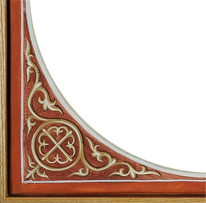- Patron Saint of Lawyers & Politicians -
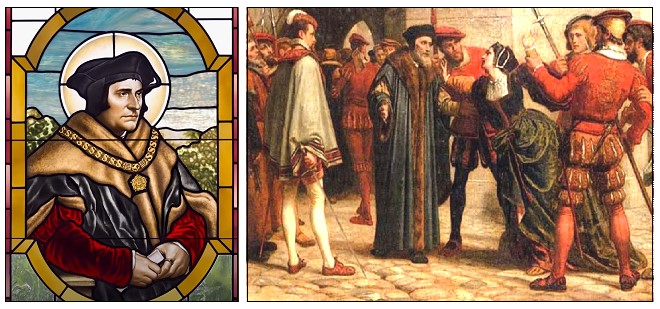
The stained-glass image of Saint Thomas More (above, left) is based upon the famous 1527 portrait painted by Hans Holbein the Younger. Painting depicting Saint Thomas More consoling his daughter, “Meg” (above, right) as he is about to be led away to his execution by beheading. During his many months of confinement in the Tower of London, a lengthy beard became self-evident. Revealing that he had lost none of his inner peace or characteristically wry sense of humor; More requested of the headsman that his beard remain untouched when the ax fell, since: “It is not guilty of treason.”
(+ 1535 A.D.)
On June 22, the Liturgical Calendar of Western Catholic Church honors the life and martyrdom of Saint Thomas More, the lawyer, author and statesman who lost his life opposing King Henry VIII’s plan to subordinate the Church to the English monarchy.
Sir Thomas More was born in 1478, the son of the lawyer and judge John More and his wife Agnes. He received a classical education from the age of six, and at age 13 became the protege of Archbishop John Morton, who also served an important civic role as the Lord Chancellor. Although Thomas never joined the clergy, he would eventually come to assume the position of Lord Chancellor himself.
More received a well-rounded college education at Oxford, becoming a true “renaissance man” who knew several ancient and modern languages and was well-versed in mathematics, music and literature. His father, however, determined that Thomas should become a lawyer, so he withdrew his son from Oxford after two years to focus him on that career.
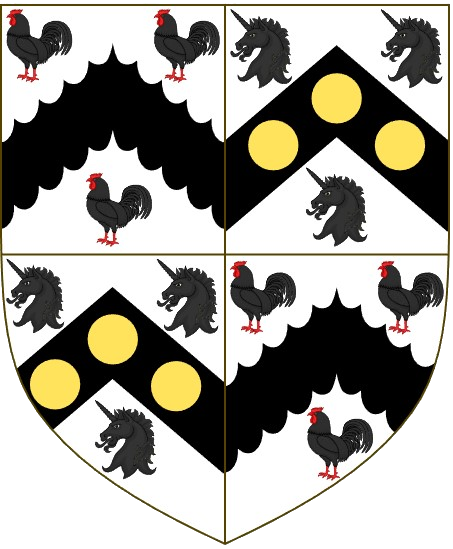 Despite his legal and political orientation, Thomas entertained doubts about his vocation. For an extended period, He seriously considered joining either the Carthusian monastic order or the Franciscans and followed a number of ascetic and spiritual practices throughout his life. These included: fasting, corporal mortification, and a regular rule of prayer as means of attaining growth in holiness.
Despite his legal and political orientation, Thomas entertained doubts about his vocation. For an extended period, He seriously considered joining either the Carthusian monastic order or the Franciscans and followed a number of ascetic and spiritual practices throughout his life. These included: fasting, corporal mortification, and a regular rule of prayer as means of attaining growth in holiness.
In 1504, however, More was elected to Parliament. He gave up his monastic ambitions, though not his disciplined spiritual life, and married Jane Colt of Essex. They were happily married for several years and had four children together, though Jane tragically died in childbirth in 1511. Shortly after her death, More married a widow named Alice Middleton, who proved to be a devoted wife and mother.
Two years earlier, in 1509, King Henry VIII had acceded to the throne. For years, the king showed fondness for Thomas, working to further his career as a public servant. More became a part of the king’s inner circle, eventually overseeing the English court system as Lord Chancellor. More even authored a book published in Henry’s name, defending Catholic doctrine against Martin Luther.
More’s eventual martyrdom would come because of Henry VIII’s own tragic downfall. The king wanted an annulment of his marriage to Catherine of Aragon, a marriage that Pope Clement VII declared to be valid and indissoluble. By 1532, More had resigned as Lord Chancellor, refusing to support the king’s efforts to defy the Pope and control the Church.
In 1534, Henry VIII declared that every subject of the British crown would have to swear an oath affirming the validity of his new marriage to Anne Boleyn. Refusal of these demands would be regarded as high treason against the state.
In April of that year, a royal commission summoned Thomas to force him to take the oath affirming the King’s new marriage as valid. While accepting certain portions of the act which pertained to Henry’s royal line of succession, he could not accept the king’s defiance of papal authority on the marriage question. More was taken from his wife and children, and subsequently imprisoned in the Tower of London.
For 15 months in the Tower of London, More’s wife and several friends tried to convince him to take the oath and save his life, but he refused. In 1535, while More was imprisoned, an act of Parliament came into effect declaring Henry VIII to be “the only supreme head on earth of the Church in England,” once again under penalty of treason. Members of the clergy who would not take the oath, including most notably Cardinal Saint John Fisher, were executed.
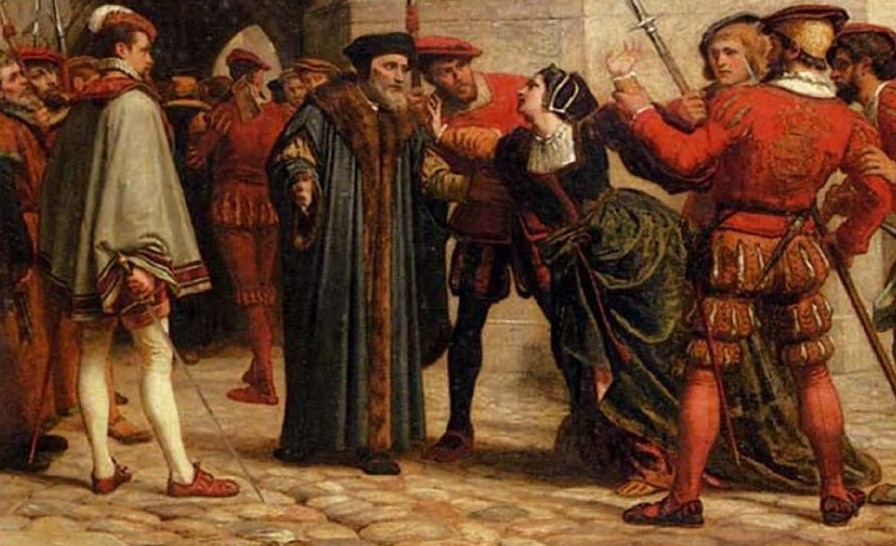
In June of 1535, More was finally indicted and formally tried for the crime of treason in Westminster Hall. He was charged with opposing the king’s “Act of Supremacy” in private conversations which he insisted had never occurred. But after his defense failed, due primarily to perjured testimony of an extremely biased political enemy, Richard Rich (pictured in the close-up image, above, standing at the extreme left of painting), he was sentenced to death. Once the sentence of death was pronounced, Sir Thomas More boldly asserted why in good conscience he could not sign an act that was contrary to the legitimate authority conferred to Saint Peter and those who would succeed him.
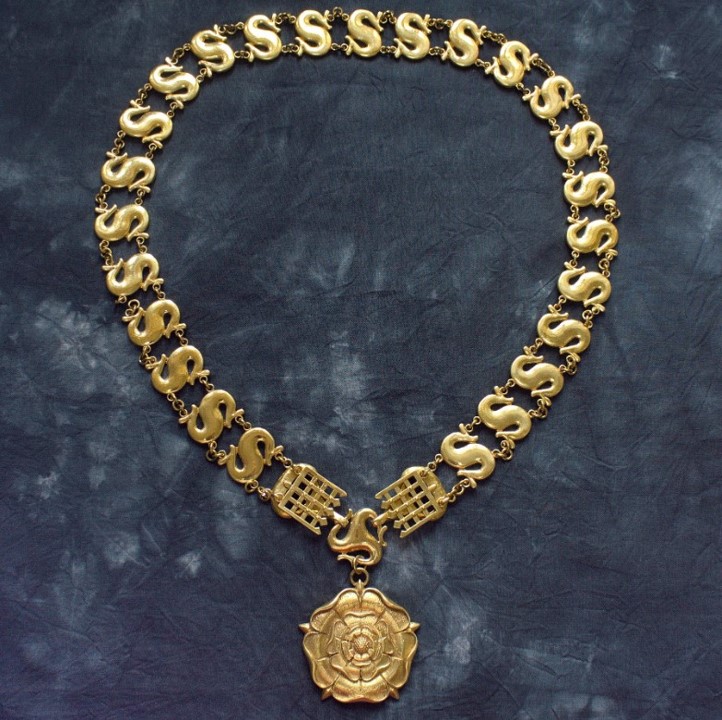
An exact replica of Thomas More’s Chain of Office (shown above) accompanies the saint’s first class relic, preserved at All Saints Shrine at Sacred Heart Byzantine Catholic Church, Livonia, MI. Its original was conferred upon More as Lord Chancellor of England under Henry VIII.

Sir Thomas More then stated that Henry’s Act of Supremacy, was contrary “to the laws of God and his Holy Church.” He further explained that “no temporal prince” could take away the prerogatives that belonged to St. Peter and his successors according to the Words of Christ. When he was informed that the vast majority of the English bishops had accepted the king’s order, except for Cardinal Saint John Fisher, More replied that the saints in heaven certainly did not accept it.
On July 6, 1535, the 57-year-old More came before the executioner to be beheaded. “I die the king’s good servant,” he told the onlookers, “but God’s first.” Upon his death, More’s head was displayed on London Bridge for a month, at “Traitor’s Gate.” Later his daughter Margaret (“Meg”), who was the only member of More’s family permitted to witness her father’s decapitation, preserved his head as a holy relic of her father, until her own death. All Saints Shrine, here at Sacred Heart Byzantine Catholic Church, is extraordinarily blessed to house a large bone fragment (ex ossibus) from the skeletal remains of this great English martyr (seen below).


Saint Thomas More was beatified by Pope Leo XIII in 1886 and canonized in 1935 by Pope Pius XI. In 1966, the Academy Award-winning Best Motion Picture of the year, “A Man For All Seasons” portrayed the events that led to saint’s martyrdom. Toward the end of his pontificate, Pope Saint John Paul II conferred upon Saint Thomas More the title, “Patron of Politicians.”




